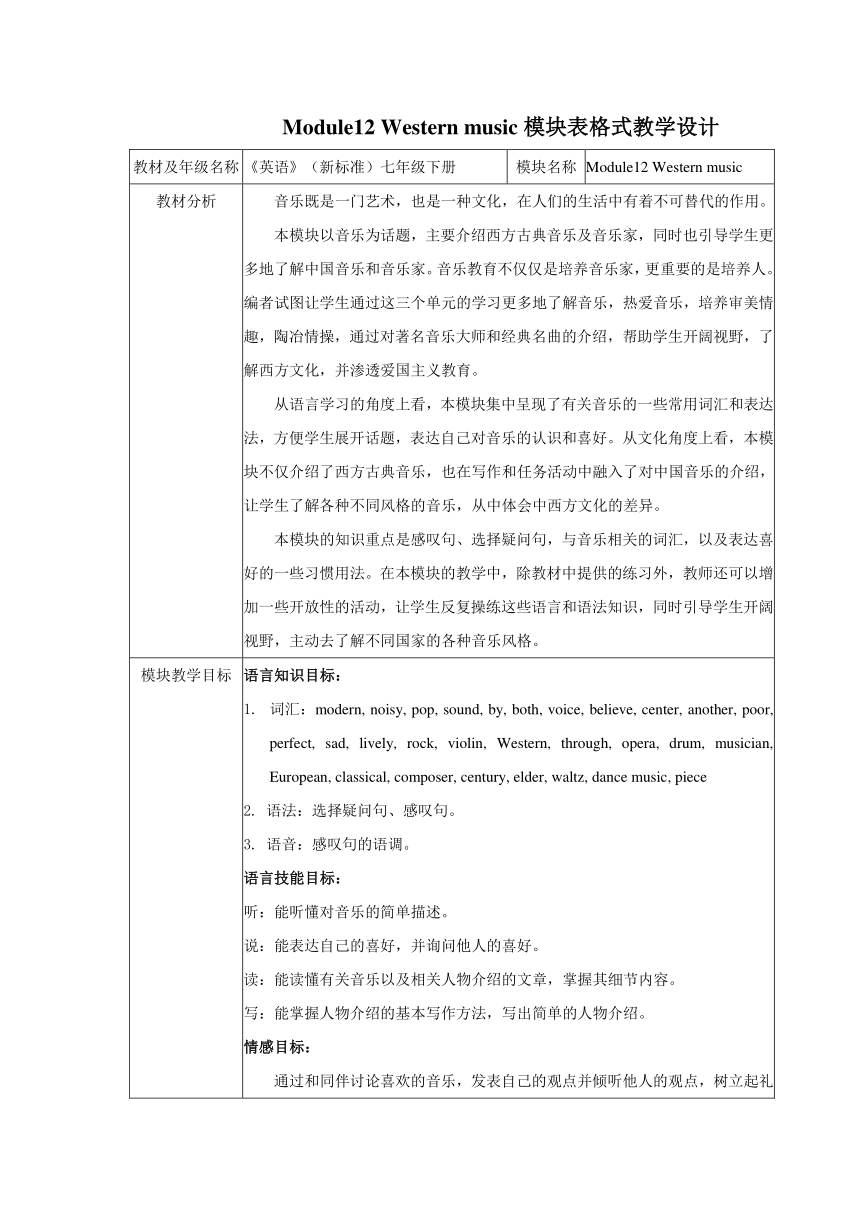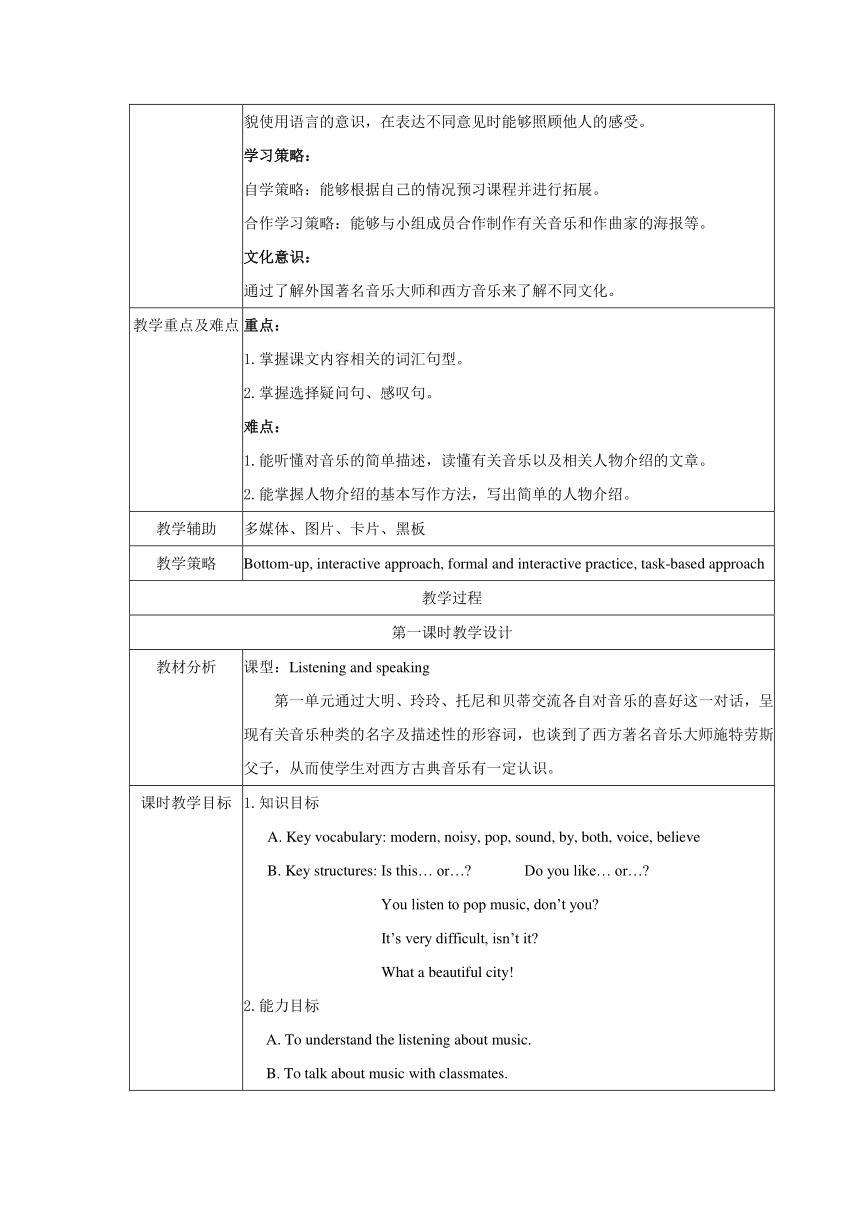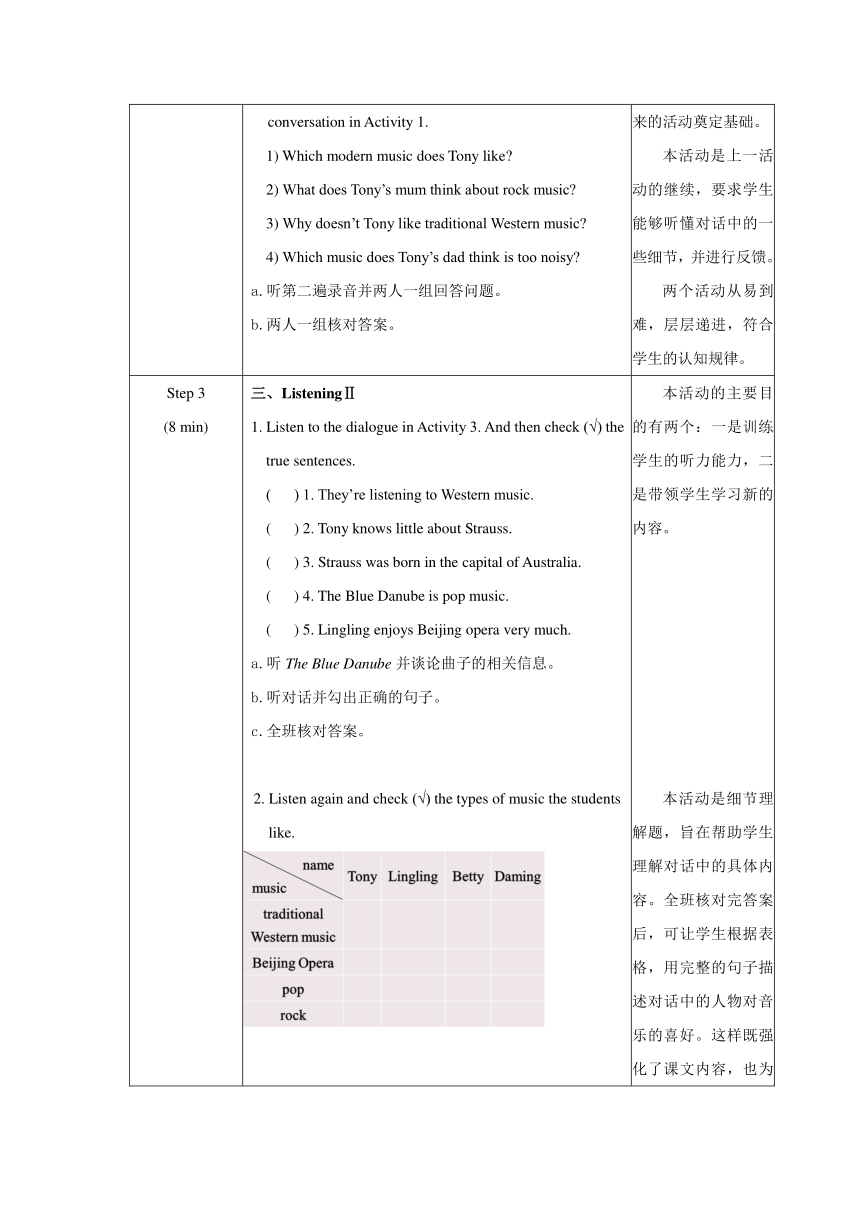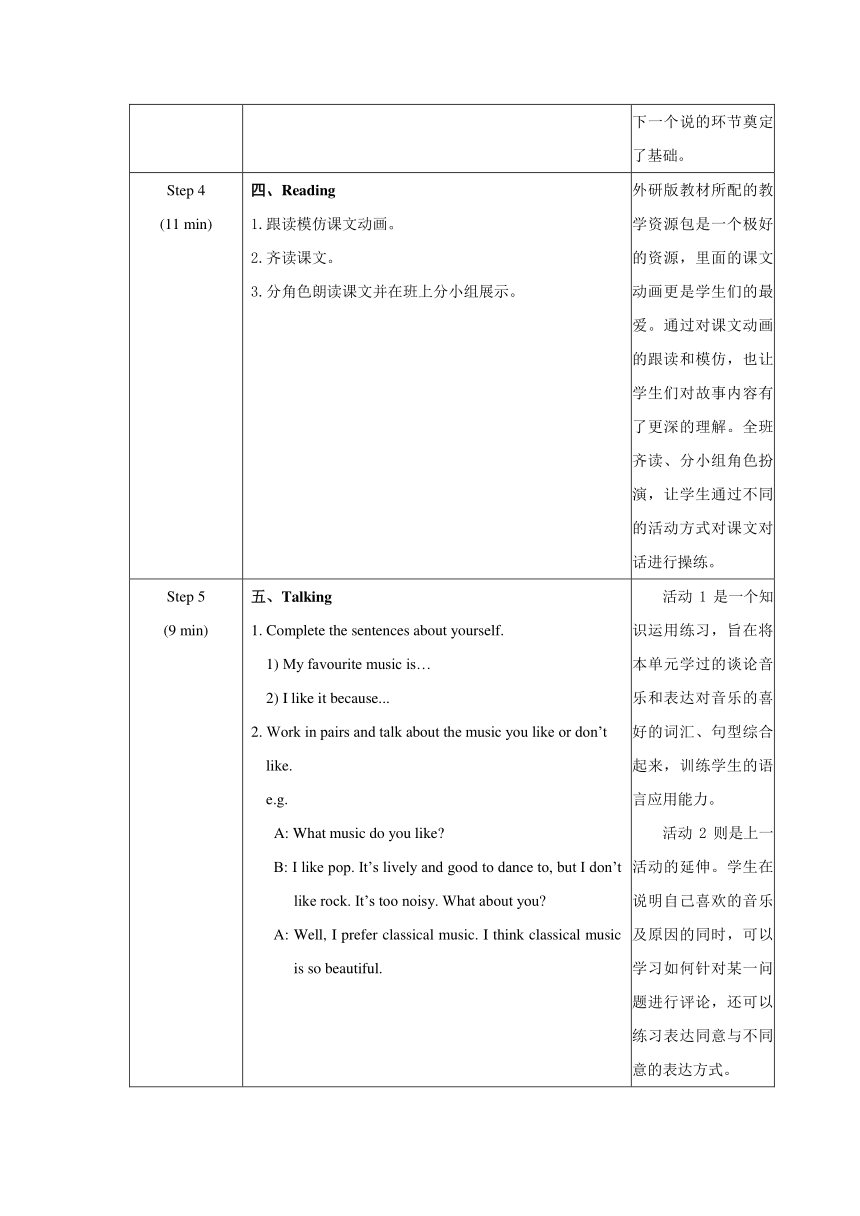Module12 Western music模块表格式教学设计
文档属性
| 名称 | Module12 Western music模块表格式教学设计 |

|
|
| 格式 | doc | ||
| 文件大小 | 796.5KB | ||
| 资源类型 | 教案 | ||
| 版本资源 | 外研版 | ||
| 科目 | 英语 | ||
| 更新时间 | 2023-01-10 23:33:48 | ||
图片预览





文档简介
Module12 Western music模块表格式教学设计
教材及年级名称 《英语》(新标准)七年级下册 模块名称 Module12 Western music
教材分析 音乐既是一门艺术,也是一种文化,在人们的生活中有着不可替代的作用。本模块以音乐为话题,主要介绍西方古典音乐及音乐家,同时也引导学生更多地了解中国音乐和音乐家。音乐教育不仅仅是培养音乐家,更重要的是培养人。编者试图让学生通过这三个单元的学习更多地了解音乐,热爱音乐,培养审美情趣,陶冶情操,通过对著名音乐大师和经典名曲的介绍,帮助学生开阔视野,了解西方文化,并渗透爱国主义教育。从语言学习的角度上看,本模块集中呈现了有关音乐的一些常用词汇和表达法,方便学生展开话题,表达自己对音乐的认识和喜好。从文化角度上看,本模块不仅介绍了西方古典音乐,也在写作和任务活动中融入了对中国音乐的介绍,让学生了解各种不同风格的音乐,从中体会中西方文化的差异。本模块的知识重点是感叹句、选择疑问句,与音乐相关的词汇,以及表达喜好的一些习惯用法。在本模块的教学中,除教材中提供的练习外,教师还可以增加一些开放性的活动,让学生反复操练这些语言和语法知识,同时引导学生开阔视野,主动去了解不同国家的各种音乐风格。
模块教学目标 语言知识目标:词汇:modern, noisy, pop, sound, by, both, voice, believe, center, another, poor, perfect, sad, lively, rock, violin, Western, through, opera, drum, musician, European, classical, composer, century, elder, waltz, dance music, piece 2. 语法:选择疑问句、感叹句。3. 语音:感叹句的语调。语言技能目标:听:能听懂对音乐的简单描述。说:能表达自己的喜好,并询问他人的喜好。读:能读懂有关音乐以及相关人物介绍的文章,掌握其细节内容。写:能掌握人物介绍的基本写作方法,写出简单的人物介绍。情感目标:通过和同伴讨论喜欢的音乐,发表自己的观点并倾听他人的观点,树立起礼貌使用语言的意识,在表达不同意见时能够照顾他人的感受。学习策略:自学策略:能够根据自己的情况预习课程并进行拓展。合作学习策略:能够与小组成员合作制作有关音乐和作曲家的海报等。文化意识:通过了解外国著名音乐大师和西方音乐来了解不同文化。
教学重点及难点 重点:1.掌握课文内容相关的词汇句型。2.掌握选择疑问句、感叹句。难点:1.能听懂对音乐的简单描述,读懂有关音乐以及相关人物介绍的文章。2.能掌握人物介绍的基本写作方法,写出简单的人物介绍。
教学辅助 多媒体、图片、卡片、黑板
教学策略 Bottom-up, interactive approach, formal and interactive practice, task-based approach
教学过程
第一课时教学设计
教材分析 课型:Listening and speaking第一单元通过大明、玲玲、托尼和贝蒂交流各自对音乐的喜好这一对话,呈现有关音乐种类的名字及描述性的形容词,也谈到了西方著名音乐大师施特劳斯父子,从而使学生对西方古典音乐有一定认识。
课时教学目标 1.知识目标A. Key vocabulary: modern, noisy, pop, sound, by, both, voice, believeB. Key structures: Is this… or… Do you like… or… You listen to pop music, don’t you It’s very difficult, isn’t it What a beautiful city!2.能力目标 A. To understand the listening about music. B. To talk about music with classmates.3. 情感目标A. To learn about Western music. B. To cultivate the awareness of competition and cooperation.
教学重点与难点 重点: A. To master some useful words and expressions about the subject.B. To understand the listening about music.难点: To talk about music in English.
教学辅助 多媒体,黑板
教学策略 Bottom-up approach, interactive approach
教学内容 教学活动 设计意图
Step 1(6 min) 一、Warming-up: 让学生欣赏一些音乐片段并就此教授新单词。 通过听一些音乐片段,让学生对音乐类型进行猜测,同时学习新单词。这很容易激发起学生的学习兴趣,并能自然地引出本节课所学的音乐主题。
Step 2(6 min) 二、ListeningⅠ1. Listen and number the words as you hear them.( )lively ( )modern ( )music ( )noisy ( ) pop ( )rock ( )sound ( )violin ( ) Western a.齐读单词。b.听并给单词按顺序标号。c.全班核对答案。2. Listen again and answer the questions about the conversation in Activity 1. 1) Which modern music does Tony like 2) What does Tony’s mum think about rock music 3) Why doesn’t Tony like traditional Western music 4) Which music does Tony’s dad think is too noisy a.听第二遍录音并两人一组回答问题。b.两人一组核对答案。 本阶段的活动涵盖了三个主要目的:一是激活学生的相关背景知识,对各类音乐及人们对于各种音乐喜好的表达有初步了解;二是培养学生的听力理解能力;三是复习前一活动中学习的生词,也为接下来的活动奠定基础。本活动是上一活动的继续,要求学生能够听懂对话中的一些细节,并进行反馈。两个活动从易到难,层层递进,符合学生的认知规律。
Step 3(8 min) 三、ListeningⅡ1. Listen to the dialogue in Activity 3. And then check (√) the true sentences.( ) 1. They’re listening to Western music. ( ) 2. Tony knows little about Strauss. ( ) 3. Strauss was born in the capital of Australia.( ) 4. The Blue Danube is pop music.( ) 5. Lingling enjoys Beijing opera very much.a.听The Blue Danube并谈论曲子的相关信息。b.听对话并勾出正确的句子。c.全班核对答案。2. Listen again and check (√) the types of music the students like. 本活动的主要目的有两个:一是训练学生的听力能力,二是带领学生学习新的内容。 本活动是细节理解题,旨在帮助学生理解对话中的具体内容。全班核对完答案后,可让学生根据表格,用完整的句子描述对话中的人物对音乐的喜好。这样既强化了课文内容,也为下一个说的环节奠定了基础。
Step 4(11 min) 四、Reading1.跟读模仿课文动画。2.齐读课文。3.分角色朗读课文并在班上分小组展示。 外研版教材所配的教学资源包是一个极好的资源,里面的课文动画更是学生们的最爱。通过对课文动画的跟读和模仿,也让学生们对故事内容有了更深的理解。全班齐读、分小组角色扮演,让学生通过不同的活动方式对课文对话进行操练。
Step 5(9 min) 五、Talking 1. Complete the sentences about yourself.1) My favourite music is… 2) I like it because...2. Work in pairs and talk about the music you like or don’t like.e.g.A: What music do you like B: I like pop. It’s lively and good to dance to, but I don’t like rock. It’s too noisy. What about you A: Well, I prefer classical music. I think classical music is so beautiful. 活动1是一个知识运用练习,旨在将本单元学过的谈论音乐和表达对音乐的喜好的词汇、句型综合起来,训练学生的语言应用能力。活动2则是上一活动的延伸。学生在说明自己喜欢的音乐及原因的同时,可以学习如何针对某一问题进行评论,还可以练习表达同意与不同意的表达方式。
Classroom Assessment Can you say the following now Check (√) the square brackets.1. I can understand the listening about music. [ ]2. I can talk about the music I like/dislike and give reason. [ ]
家庭作业 Talk about your favourite music with you friends.
第二课时教学设计
教材分析 课型:Reading and writing第二单元的课文以“The city of music”为题,介绍了音乐之都维也纳及奥地利作曲家施特劳斯和莫扎特,语言精练、自然、优美。同时,课文还可以看作是介绍人物的一个典型范例,尤其是介绍莫扎特的段落,寥寥八十几个词概括了莫扎特的一生,语言精练,结构紧凑,且逻辑性强,是很好的语言表达示范。这篇课文同样采取的是“总述—分述”的结构,第一段介绍了维也纳的音乐地位,然后介绍了代表人物:施特劳斯和莫扎特。
课时教学目标 1.知识目标A. Key vocabulary: center, another, poor, prefectB. Key structures: In the eighteenth century… …, called… He played not only… but also…2.能力目标 A. To understand the description of Vienna and the composers. B. To be able to write a passage about Xian Xinghai.3.情感目标A. To learn about foreign culture through learning Western music and musicians. B. To cultivate the awareness of competition and cooperation.
教学重点与难点 1.重点:A. To master some useful words and expressions about the subject.B. To improve the ability of reading.2.难点:To be able to write a passage about Xian Xinghai.
教学辅助 多媒体,图片,黑板
教学策略 Bottom-up approach
教学内容 教学活动 设计意图
Step 1(5 min) 一、Warming-up介绍一些著名的音乐家。 热身活动中给学生介绍了一些世界著名的音乐家,既丰富了课外知识,也为引出本节课即将学习的音乐家做铺垫。
Step 2(4 min) 二、Pre-readingWork in pairs. Look at the picture of Activity 1 and describe it. Use the words from the box to help my students. concert musician piano violin 此读前活动激活了学生已有的音乐常识,同时为后面的阅读做词汇上的铺垫。
Step 3(18 min) 三、While-reading1. Fast-reading快速阅读文章回答问题。Q: How many musicians are mentioned in it Who are they 2. Careful-reading1) Read the 1st paragraph quickly and complete the passage. Vienna is a city on the River _______. It’s the capital of _______ and the centre of European _______ music. In the 18th century, a lot of _______ came to study and work.2) Read the 2nd paragraph and complete the table. the Strauss familyNameAchievement3) Read the 3rd paragraph and check (√) the true sentences.Mozart was born in Australia. ( )Before he was six, he played the violin and the piano. ( )The family took Mozart around Europe. ( )He died in 1791 when he was only 35. ( )He was famous as a great European composer. ( )3. 跟读模仿课文动画中的语音语调。 通过快速阅读让学生了解文章结构。细节阅读中,通过分段阅读降低了阅读难度,同时,每段阅读前展示一些段落的背景信息,例如维也纳、施特劳斯、莫扎特的介绍,增加了阅读的趣味性,激发了学生的阅读兴趣。
Step 4(13 min) 四、After-reading 1.根据课文内容完成下列表格并根据表格内容对课文进行复述。2.游戏:Who was I 假设你是一名著名的音乐家,请用3~4句话描述自己,但不要提及姓名,让同学们猜猜你是谁。a.老师先举一个冼星海的例子:e.g. T: I was born in Macao, China, 1905. I studied in Paris. I was called the People’s Musician. I was famous for the song The Yellow River. Who was I Ss: Xian Xinghai.b.给3分钟时间让学生做准备。Useful expressions & sentence structures:not only… but also… / give concerts / be popular with… I was born in… / I came from…I was famous as…/for…I… 分段阅读后让学生对文章主要信息进行总结概括,并进行口头复述。这样既熟悉了课文内容又锻炼了口头表达能力,为课后写作奠定基础。 “猜猜我是谁”游戏旨在让学生学会如何描述名人的生平事迹,增加了课堂的趣味性,也为课后的相关作文奠定基础。
Classroom Assessment Can you say the following now Check (√) the square brackets.1. I can understand the passage about city of music. [ ]2. I can write something about a musician. [ ]
家庭作业 Write about your favorite musician. If you find it difficult, you can write about Xian Xinghai by using the notes in Activity 5. Your writings are ready for your music posters’ making.
第三课时教学设计
教材分析 课型:Revision and application 第三单元是对选择疑问句和感叹句的操练和巩固。活动和任务涉及更多关于音乐的知识,包含维也纳新年音乐会。让学生在学习西方音乐的同时也有机会谈论中国音乐,帮助他们了解中国传统文化,并有意识地通过音乐比较中西方文化的差异。
课时教学目标 1.知识目标To practise the key words of this module.2.能力目标A. To practise exclamatory sentences and alternative questions.B. To practise the expression of preference.3.情感目标 A. To learn about foreign culture through learning Western music and Vienna.B. To compare the differences between Western music and Chinese music.
教学重点与难点 重点:To practise the key words of this module.难点:A. To practise exclamatory sentences and alternative questions.B. To practise the expression of preference.
教学辅助 多媒体,黑板
教学策略 Formal and interactive practice, task-based approach
教学内容 教学活动 设计意图
Step 1(8 min) 一、Vocabulary1. Put the words into the correct column. drum fan musician piano poprock traditional violinTypes of musicInstrumentsPeople2. Complete the conversation of Activity 4 with the correct form of the words from the e give hear learn love writeLingling: This is beautiful music. Is it by Mozart or Beethoven Betty: Beethoven wrote it. He was a great musician. I (1) ______ his music.Lingling: Me too. Did he live at the same time as Mozart Betty: Yes, he was born in 1770 and began to (2) ______ music at an early age. He (3) ______ his first piano concert when he was only seven.Lingling: When did he start to (4) ______ music Betty: Very early. His first work (5) ______ out before the age of thirteen.Lingling: Was Beethoven famous at that time Betty: Yes. But he began to lose his hearing. In the last ten years of Beethoven’s life, he (6) ______ nothing.Lingling: That’s sad!Betty: Yes, but he still played the piano. He died when he was fifty-six. 本活动为词汇学习活动,归纳本模块学习过的一些与音乐有关的话题词,让学生用分类方法对这些词汇加深理解,同时希望学生通过此活动掌握学习词汇的方法和策略,既可以帮助学生记住更多的单词,同时达到复习同类词汇的目的。本活动为具体语境中的词汇运用练习,需要学生根据对话内容运用所学动词进行填空。文中划线句子也为后面的感叹句和选择疑问句埋下伏笔。
Step 2(20 min) 二、Language practice1. Alternative questionsa. Presentation:首先看下面的句子:Is this by Mozart or Beethoven (连接两个名词) It’s by Strauss. Do you like traditional Western music or pop music (连接两个名词短语)Well, I like both. b. Conclusion:选择疑问句,在结构上可用一般疑问句也可用特殊疑问句,两种(或两种以上)情况由or连接起来。选择疑问句在作答时不用Yes或No,而要做出具体的回答选择。 选择疑问句中的or可以连接不同的内容:两个名词、动词、介词短语等等,但通常是并列结构,即前后一致的结构。c. Practice:根据汉语意思完成英语句子或对话。(1)这些椅子是新的还是旧的? ____ the chairs ____________ (2)—你喜欢连衣裙还是短裙? —我喜欢短裙。 — ____ you like ___________________ — ______________.(3)—你来自哪儿,大连还是北京? —北京。 — ______ do you come from, Dalian ___ Beijing — ________.连词成句:例句:you / like / pop / traditional music →Do you like pop or traditional music (1) (be) / Strauss / German / Austrian _______________________________________ (2) (be) / this / pop / rock _______________________________________ (3) they / play / traditional music / modern music _______________________________________ (4) he / play / piano / violin _______________________________________ (5) where / (can) we / hear / rock music / in / New York / London _______________________________________ 2. Exclamatory sentencesa. Presentation: This is beautiful music! → What beautiful music this is!b. Conclusion:用来表达喜悦、赞叹、惊异、愤怒、厌恶等较为强烈感情的句子叫作感叹句。一、what引导的感叹句有三种形式:◆ What + a/an +形容词+可数名词单数(+主语+谓语)! ◆ What+形容词+可数名词复数(+主语+谓语)! ◆ What+形容词+不可数名词(+主语+谓语)! c. Practice:根据句意从括号内选出适当的一项填空。(1) ______ (What / What a) delicious chicken we are having!(2) _________ (What / What an) interesting book it is!(3) ________ (What / What a) nice shirt you bought! 选择正确的选项。1. ______ clever boy he is! A. What a B. What C. What an 2. ______ delicious soup! A. What an B. What C. What a3. ______ fine weather it is today! A. What an B. What a C. What4. ______ beautiful flowers they are! A. What an B. What C. What a 本环节为语言操练环节,选择疑问句和感叹句的学习是重点。从例句的呈现、结构的总结,再到之后多种形式的句型操练,从易至难,步步深入,符合学生的认知规律。
Step 3(3 min) 三、Around the world这篇文章主要讲述了维也纳音乐会。 本部分结合第二单元中的阅读课文,介绍了闻名世界的维也纳新年音乐会。因最初是由施特劳斯家族举办的,所以到现在每届音乐会上都会演奏施特劳斯的作品。学生可通过维也纳新年音乐会这一窗口进一步了解施特劳斯家族和西方音乐。
Step 4(9 min) 四、Module task — Talking about Chinese music.谈论一至两种中国传统音乐。 本模块的任务活动为谈论中国音乐的类型。通过对中国音乐的谈论,可将中国音乐与西方音乐进行对比,并帮助学生更熟练地表达自己对音乐的喜好。
Classroom Assessment 课堂学习效果评估Can you say the following now Check (√) the square brackets.1. I can master exclamatory sentences and alternative questions. [ ] 2. I can express my preference about music freely. [ ]
家庭作业 Make a music poster about your favourite music and musicians.
教材及年级名称 《英语》(新标准)七年级下册 模块名称 Module12 Western music
教材分析 音乐既是一门艺术,也是一种文化,在人们的生活中有着不可替代的作用。本模块以音乐为话题,主要介绍西方古典音乐及音乐家,同时也引导学生更多地了解中国音乐和音乐家。音乐教育不仅仅是培养音乐家,更重要的是培养人。编者试图让学生通过这三个单元的学习更多地了解音乐,热爱音乐,培养审美情趣,陶冶情操,通过对著名音乐大师和经典名曲的介绍,帮助学生开阔视野,了解西方文化,并渗透爱国主义教育。从语言学习的角度上看,本模块集中呈现了有关音乐的一些常用词汇和表达法,方便学生展开话题,表达自己对音乐的认识和喜好。从文化角度上看,本模块不仅介绍了西方古典音乐,也在写作和任务活动中融入了对中国音乐的介绍,让学生了解各种不同风格的音乐,从中体会中西方文化的差异。本模块的知识重点是感叹句、选择疑问句,与音乐相关的词汇,以及表达喜好的一些习惯用法。在本模块的教学中,除教材中提供的练习外,教师还可以增加一些开放性的活动,让学生反复操练这些语言和语法知识,同时引导学生开阔视野,主动去了解不同国家的各种音乐风格。
模块教学目标 语言知识目标:词汇:modern, noisy, pop, sound, by, both, voice, believe, center, another, poor, perfect, sad, lively, rock, violin, Western, through, opera, drum, musician, European, classical, composer, century, elder, waltz, dance music, piece 2. 语法:选择疑问句、感叹句。3. 语音:感叹句的语调。语言技能目标:听:能听懂对音乐的简单描述。说:能表达自己的喜好,并询问他人的喜好。读:能读懂有关音乐以及相关人物介绍的文章,掌握其细节内容。写:能掌握人物介绍的基本写作方法,写出简单的人物介绍。情感目标:通过和同伴讨论喜欢的音乐,发表自己的观点并倾听他人的观点,树立起礼貌使用语言的意识,在表达不同意见时能够照顾他人的感受。学习策略:自学策略:能够根据自己的情况预习课程并进行拓展。合作学习策略:能够与小组成员合作制作有关音乐和作曲家的海报等。文化意识:通过了解外国著名音乐大师和西方音乐来了解不同文化。
教学重点及难点 重点:1.掌握课文内容相关的词汇句型。2.掌握选择疑问句、感叹句。难点:1.能听懂对音乐的简单描述,读懂有关音乐以及相关人物介绍的文章。2.能掌握人物介绍的基本写作方法,写出简单的人物介绍。
教学辅助 多媒体、图片、卡片、黑板
教学策略 Bottom-up, interactive approach, formal and interactive practice, task-based approach
教学过程
第一课时教学设计
教材分析 课型:Listening and speaking第一单元通过大明、玲玲、托尼和贝蒂交流各自对音乐的喜好这一对话,呈现有关音乐种类的名字及描述性的形容词,也谈到了西方著名音乐大师施特劳斯父子,从而使学生对西方古典音乐有一定认识。
课时教学目标 1.知识目标A. Key vocabulary: modern, noisy, pop, sound, by, both, voice, believeB. Key structures: Is this… or… Do you like… or… You listen to pop music, don’t you It’s very difficult, isn’t it What a beautiful city!2.能力目标 A. To understand the listening about music. B. To talk about music with classmates.3. 情感目标A. To learn about Western music. B. To cultivate the awareness of competition and cooperation.
教学重点与难点 重点: A. To master some useful words and expressions about the subject.B. To understand the listening about music.难点: To talk about music in English.
教学辅助 多媒体,黑板
教学策略 Bottom-up approach, interactive approach
教学内容 教学活动 设计意图
Step 1(6 min) 一、Warming-up: 让学生欣赏一些音乐片段并就此教授新单词。 通过听一些音乐片段,让学生对音乐类型进行猜测,同时学习新单词。这很容易激发起学生的学习兴趣,并能自然地引出本节课所学的音乐主题。
Step 2(6 min) 二、ListeningⅠ1. Listen and number the words as you hear them.( )lively ( )modern ( )music ( )noisy ( ) pop ( )rock ( )sound ( )violin ( ) Western a.齐读单词。b.听并给单词按顺序标号。c.全班核对答案。2. Listen again and answer the questions about the conversation in Activity 1. 1) Which modern music does Tony like 2) What does Tony’s mum think about rock music 3) Why doesn’t Tony like traditional Western music 4) Which music does Tony’s dad think is too noisy a.听第二遍录音并两人一组回答问题。b.两人一组核对答案。 本阶段的活动涵盖了三个主要目的:一是激活学生的相关背景知识,对各类音乐及人们对于各种音乐喜好的表达有初步了解;二是培养学生的听力理解能力;三是复习前一活动中学习的生词,也为接下来的活动奠定基础。本活动是上一活动的继续,要求学生能够听懂对话中的一些细节,并进行反馈。两个活动从易到难,层层递进,符合学生的认知规律。
Step 3(8 min) 三、ListeningⅡ1. Listen to the dialogue in Activity 3. And then check (√) the true sentences.( ) 1. They’re listening to Western music. ( ) 2. Tony knows little about Strauss. ( ) 3. Strauss was born in the capital of Australia.( ) 4. The Blue Danube is pop music.( ) 5. Lingling enjoys Beijing opera very much.a.听The Blue Danube并谈论曲子的相关信息。b.听对话并勾出正确的句子。c.全班核对答案。2. Listen again and check (√) the types of music the students like. 本活动的主要目的有两个:一是训练学生的听力能力,二是带领学生学习新的内容。 本活动是细节理解题,旨在帮助学生理解对话中的具体内容。全班核对完答案后,可让学生根据表格,用完整的句子描述对话中的人物对音乐的喜好。这样既强化了课文内容,也为下一个说的环节奠定了基础。
Step 4(11 min) 四、Reading1.跟读模仿课文动画。2.齐读课文。3.分角色朗读课文并在班上分小组展示。 外研版教材所配的教学资源包是一个极好的资源,里面的课文动画更是学生们的最爱。通过对课文动画的跟读和模仿,也让学生们对故事内容有了更深的理解。全班齐读、分小组角色扮演,让学生通过不同的活动方式对课文对话进行操练。
Step 5(9 min) 五、Talking 1. Complete the sentences about yourself.1) My favourite music is… 2) I like it because...2. Work in pairs and talk about the music you like or don’t like.e.g.A: What music do you like B: I like pop. It’s lively and good to dance to, but I don’t like rock. It’s too noisy. What about you A: Well, I prefer classical music. I think classical music is so beautiful. 活动1是一个知识运用练习,旨在将本单元学过的谈论音乐和表达对音乐的喜好的词汇、句型综合起来,训练学生的语言应用能力。活动2则是上一活动的延伸。学生在说明自己喜欢的音乐及原因的同时,可以学习如何针对某一问题进行评论,还可以练习表达同意与不同意的表达方式。
Classroom Assessment Can you say the following now Check (√) the square brackets.1. I can understand the listening about music. [ ]2. I can talk about the music I like/dislike and give reason. [ ]
家庭作业 Talk about your favourite music with you friends.
第二课时教学设计
教材分析 课型:Reading and writing第二单元的课文以“The city of music”为题,介绍了音乐之都维也纳及奥地利作曲家施特劳斯和莫扎特,语言精练、自然、优美。同时,课文还可以看作是介绍人物的一个典型范例,尤其是介绍莫扎特的段落,寥寥八十几个词概括了莫扎特的一生,语言精练,结构紧凑,且逻辑性强,是很好的语言表达示范。这篇课文同样采取的是“总述—分述”的结构,第一段介绍了维也纳的音乐地位,然后介绍了代表人物:施特劳斯和莫扎特。
课时教学目标 1.知识目标A. Key vocabulary: center, another, poor, prefectB. Key structures: In the eighteenth century… …, called… He played not only… but also…2.能力目标 A. To understand the description of Vienna and the composers. B. To be able to write a passage about Xian Xinghai.3.情感目标A. To learn about foreign culture through learning Western music and musicians. B. To cultivate the awareness of competition and cooperation.
教学重点与难点 1.重点:A. To master some useful words and expressions about the subject.B. To improve the ability of reading.2.难点:To be able to write a passage about Xian Xinghai.
教学辅助 多媒体,图片,黑板
教学策略 Bottom-up approach
教学内容 教学活动 设计意图
Step 1(5 min) 一、Warming-up介绍一些著名的音乐家。 热身活动中给学生介绍了一些世界著名的音乐家,既丰富了课外知识,也为引出本节课即将学习的音乐家做铺垫。
Step 2(4 min) 二、Pre-readingWork in pairs. Look at the picture of Activity 1 and describe it. Use the words from the box to help my students. concert musician piano violin 此读前活动激活了学生已有的音乐常识,同时为后面的阅读做词汇上的铺垫。
Step 3(18 min) 三、While-reading1. Fast-reading快速阅读文章回答问题。Q: How many musicians are mentioned in it Who are they 2. Careful-reading1) Read the 1st paragraph quickly and complete the passage. Vienna is a city on the River _______. It’s the capital of _______ and the centre of European _______ music. In the 18th century, a lot of _______ came to study and work.2) Read the 2nd paragraph and complete the table. the Strauss familyNameAchievement3) Read the 3rd paragraph and check (√) the true sentences.Mozart was born in Australia. ( )Before he was six, he played the violin and the piano. ( )The family took Mozart around Europe. ( )He died in 1791 when he was only 35. ( )He was famous as a great European composer. ( )3. 跟读模仿课文动画中的语音语调。 通过快速阅读让学生了解文章结构。细节阅读中,通过分段阅读降低了阅读难度,同时,每段阅读前展示一些段落的背景信息,例如维也纳、施特劳斯、莫扎特的介绍,增加了阅读的趣味性,激发了学生的阅读兴趣。
Step 4(13 min) 四、After-reading 1.根据课文内容完成下列表格并根据表格内容对课文进行复述。2.游戏:Who was I 假设你是一名著名的音乐家,请用3~4句话描述自己,但不要提及姓名,让同学们猜猜你是谁。a.老师先举一个冼星海的例子:e.g. T: I was born in Macao, China, 1905. I studied in Paris. I was called the People’s Musician. I was famous for the song The Yellow River. Who was I Ss: Xian Xinghai.b.给3分钟时间让学生做准备。Useful expressions & sentence structures:not only… but also… / give concerts / be popular with… I was born in… / I came from…I was famous as…/for…I… 分段阅读后让学生对文章主要信息进行总结概括,并进行口头复述。这样既熟悉了课文内容又锻炼了口头表达能力,为课后写作奠定基础。 “猜猜我是谁”游戏旨在让学生学会如何描述名人的生平事迹,增加了课堂的趣味性,也为课后的相关作文奠定基础。
Classroom Assessment Can you say the following now Check (√) the square brackets.1. I can understand the passage about city of music. [ ]2. I can write something about a musician. [ ]
家庭作业 Write about your favorite musician. If you find it difficult, you can write about Xian Xinghai by using the notes in Activity 5. Your writings are ready for your music posters’ making.
第三课时教学设计
教材分析 课型:Revision and application 第三单元是对选择疑问句和感叹句的操练和巩固。活动和任务涉及更多关于音乐的知识,包含维也纳新年音乐会。让学生在学习西方音乐的同时也有机会谈论中国音乐,帮助他们了解中国传统文化,并有意识地通过音乐比较中西方文化的差异。
课时教学目标 1.知识目标To practise the key words of this module.2.能力目标A. To practise exclamatory sentences and alternative questions.B. To practise the expression of preference.3.情感目标 A. To learn about foreign culture through learning Western music and Vienna.B. To compare the differences between Western music and Chinese music.
教学重点与难点 重点:To practise the key words of this module.难点:A. To practise exclamatory sentences and alternative questions.B. To practise the expression of preference.
教学辅助 多媒体,黑板
教学策略 Formal and interactive practice, task-based approach
教学内容 教学活动 设计意图
Step 1(8 min) 一、Vocabulary1. Put the words into the correct column. drum fan musician piano poprock traditional violinTypes of musicInstrumentsPeople2. Complete the conversation of Activity 4 with the correct form of the words from the e give hear learn love writeLingling: This is beautiful music. Is it by Mozart or Beethoven Betty: Beethoven wrote it. He was a great musician. I (1) ______ his music.Lingling: Me too. Did he live at the same time as Mozart Betty: Yes, he was born in 1770 and began to (2) ______ music at an early age. He (3) ______ his first piano concert when he was only seven.Lingling: When did he start to (4) ______ music Betty: Very early. His first work (5) ______ out before the age of thirteen.Lingling: Was Beethoven famous at that time Betty: Yes. But he began to lose his hearing. In the last ten years of Beethoven’s life, he (6) ______ nothing.Lingling: That’s sad!Betty: Yes, but he still played the piano. He died when he was fifty-six. 本活动为词汇学习活动,归纳本模块学习过的一些与音乐有关的话题词,让学生用分类方法对这些词汇加深理解,同时希望学生通过此活动掌握学习词汇的方法和策略,既可以帮助学生记住更多的单词,同时达到复习同类词汇的目的。本活动为具体语境中的词汇运用练习,需要学生根据对话内容运用所学动词进行填空。文中划线句子也为后面的感叹句和选择疑问句埋下伏笔。
Step 2(20 min) 二、Language practice1. Alternative questionsa. Presentation:首先看下面的句子:Is this by Mozart or Beethoven (连接两个名词) It’s by Strauss. Do you like traditional Western music or pop music (连接两个名词短语)Well, I like both. b. Conclusion:选择疑问句,在结构上可用一般疑问句也可用特殊疑问句,两种(或两种以上)情况由or连接起来。选择疑问句在作答时不用Yes或No,而要做出具体的回答选择。 选择疑问句中的or可以连接不同的内容:两个名词、动词、介词短语等等,但通常是并列结构,即前后一致的结构。c. Practice:根据汉语意思完成英语句子或对话。(1)这些椅子是新的还是旧的? ____ the chairs ____________ (2)—你喜欢连衣裙还是短裙? —我喜欢短裙。 — ____ you like ___________________ — ______________.(3)—你来自哪儿,大连还是北京? —北京。 — ______ do you come from, Dalian ___ Beijing — ________.连词成句:例句:you / like / pop / traditional music →Do you like pop or traditional music (1) (be) / Strauss / German / Austrian _______________________________________ (2) (be) / this / pop / rock _______________________________________ (3) they / play / traditional music / modern music _______________________________________ (4) he / play / piano / violin _______________________________________ (5) where / (can) we / hear / rock music / in / New York / London _______________________________________ 2. Exclamatory sentencesa. Presentation: This is beautiful music! → What beautiful music this is!b. Conclusion:用来表达喜悦、赞叹、惊异、愤怒、厌恶等较为强烈感情的句子叫作感叹句。一、what引导的感叹句有三种形式:◆ What + a/an +形容词+可数名词单数(+主语+谓语)! ◆ What+形容词+可数名词复数(+主语+谓语)! ◆ What+形容词+不可数名词(+主语+谓语)! c. Practice:根据句意从括号内选出适当的一项填空。(1) ______ (What / What a) delicious chicken we are having!(2) _________ (What / What an) interesting book it is!(3) ________ (What / What a) nice shirt you bought! 选择正确的选项。1. ______ clever boy he is! A. What a B. What C. What an 2. ______ delicious soup! A. What an B. What C. What a3. ______ fine weather it is today! A. What an B. What a C. What4. ______ beautiful flowers they are! A. What an B. What C. What a 本环节为语言操练环节,选择疑问句和感叹句的学习是重点。从例句的呈现、结构的总结,再到之后多种形式的句型操练,从易至难,步步深入,符合学生的认知规律。
Step 3(3 min) 三、Around the world这篇文章主要讲述了维也纳音乐会。 本部分结合第二单元中的阅读课文,介绍了闻名世界的维也纳新年音乐会。因最初是由施特劳斯家族举办的,所以到现在每届音乐会上都会演奏施特劳斯的作品。学生可通过维也纳新年音乐会这一窗口进一步了解施特劳斯家族和西方音乐。
Step 4(9 min) 四、Module task — Talking about Chinese music.谈论一至两种中国传统音乐。 本模块的任务活动为谈论中国音乐的类型。通过对中国音乐的谈论,可将中国音乐与西方音乐进行对比,并帮助学生更熟练地表达自己对音乐的喜好。
Classroom Assessment 课堂学习效果评估Can you say the following now Check (√) the square brackets.1. I can master exclamatory sentences and alternative questions. [ ] 2. I can express my preference about music freely. [ ]
家庭作业 Make a music poster about your favourite music and musicians.
同课章节目录
- Module 1 Lost and found
- Unit 1 Whose bag is this?
- Unit 2 Are they yours?
- Unit 3 Language in use
- Module 2 What can you do ?
- Unit 1 I can play the piano
- Unit 2 I can run really fast
- Unit 3 Language in use
- Module 3 Making plans
- Unit 1 What are you going to do at the weekends?
- Unit 2 We're going to cheer the players.
- Unit 3 Language in use
- Module 4 Life in the future
- Unit 1 Everyone will study at home
- Unit 2 Every family will have a small plane.
- Unit 3 Language in use
- Module 5 Shopping
- Unit 1 What can I do for you?
- Unit 2 You can buy everything on the Internet
- Unit 3 Language in use
- Module 6 Around town
- Unit 1 Could you tell me how to get to the Nationa
- Unit 2 The London Eye is on your right.
- Unit 3 Language in use
- Revision module A
- Module 7 My past life
- Unit 1 I was born in a small village.
- Unit 2 I was born in Quincy.
- Unit 3 Language in use
- Module 8 Story time
- Unit 1 Once upon a time….
- Unit 2 Goldilocks hurried out of the house.
- Unit 3 Language in use
- Module 9 Life history
- Unit 1 He left school and began work at the age of
- Unit 2 He decided to be an actor.
- Unit 3 Language in use
- Module 10 A holiday journey
- Unit 1 What did you do?
- Unit 2 This morning we took a walk.
- Unit 3 Language in use
- Module 11 Body language
- Unit 1 They touch noses!
- Unit 2 Here are some ways to welcome them.
- Unit 3 Language in use
- Module 12 Western music
- Unit 1 It's so beautiful!
- Unit 2 Vienna is the centre of European classical
- Unit 3 Language in use
- Revision module B
